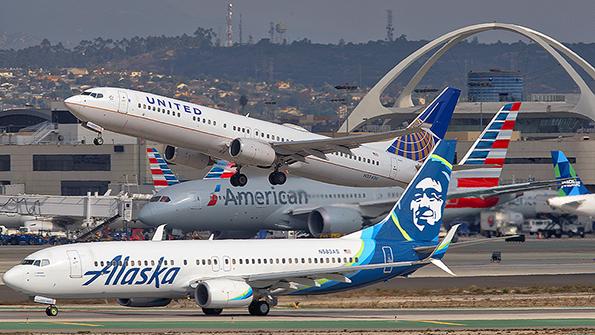
North American passenger carriers were able to avoid the high-profile airline failures seen in other regions of the world, but their road to recovery remains long and there is no clear indication when daily losses will cease.
In the US, airlines were provided an emergency lifeline by Congress in the form of the Coronavirus Aid, Relief and Economic Security (CARES) Act. The law’s $50 billion in targeted airline relief was split evenly between worker subsidies and low-interest loans. In addition to the government largesse, carriers raised more than $50 billion from the capital markets, mortgaging everything from gates and routes to aircraft and frequent-flier programs.
With basic survival no longer an immediate concern, US airlines have shifted their sights from shoring up liquidity to stamping out daily cash burn. Despite massive cost-cutting efforts this year, the three large full-service carriers still expect to collectively burn through as much as $50 billion per day in the 2020 fourth quarter. Both Delta Air Lines and United Airlines have forecast breaking even by spring 2021, while American Airlines—which has the largest cash outflows in the industry—has declined to speculate when its losses may cease.
Domestic market regrowth
Passenger throughput screened by the US Transportation Security Administration has recently begun regularly approaching 1 million people per day on peak days, or around 40% of the 2.5 million people who traveled on the average day in 2019. But the recovery has been almost entirely centered on domestic leisure travel, with legacy airlines reporting business volumes down 85%-90%. Long-haul international, on the other hand, was down nearly 80% as of mid-October, according to industry trade group Airlines for America (A4A).
US citizens remain effectively banned from traveling to huge swathes of the globe, including the Canada, China, the European Union and the UK, because of mandatory quarantines and border closures.
The general industry consensus, best articulated by United CEO Scott Kirby, is that demand will struggle to exceed 50% of last year’s levels—or around 1.25 million people per day—until a vaccine is widely available, which most industry watchers don’t expect until the back half of 2021. While carriers are hopeful about the potential for pre-flight COVID-19 testing to speed up the return of long-haul flights, such efforts remain in their early stages, and key questions remain over logistics, cost and government adoption.
As such, Chicago-based United is not planning for much additional growth in the first quarter of 2021 beyond the 45% overall schedule it plans to operate in the final three months of this year. By comparison, American Airlines and Delta Air Lines plan for Q4 capacity to be down around 50% and 45%-50%, respectively.
Domestic and low-cost carriers like Alaska Airlines, JetBlue Airways and Southwest Airlines will operate slightly more—around 55%-60% of year-ago levels—while ULCCs like Allegiant Air and Spirit Airlines hope to return to nearly full capacity during the December quarter.
Moving forward, airlines will have the benefit of lower labor costs, but it will come at the expense of around 45,000 involuntary furloughs. In addition, tens of thousands of staff voluntarily departed or took extended, unpaid leaves of absence. All told, Cowen & Co. analyst Helane Becker estimates the US airline industry will employ between 500,000 and 550,000 people by the end of the year, down from around 700,000 in January.
Carriers have also looked to fleet simplification as a lever to wring out additional costs. American retired all of its Airbus A330-200/300s, Boeing 757-200s and 767-300ERs, and Embraer E190s, while Delta removed all its Boeing MD-88s, MD-90s, 737-700s and 777-200ER/LRs. United, on the other hand, has opted against retiring any aircraft specifically due to the pandemic, preferring instead to place large numbers of jets into long-term storage until the path of future demand becomes clear.
Harder for regionals
While US full-service carriers have plenty of liquidity to survive a protracted downturn, their regional affiliates have not been as fortunate. Four US regionals have failed so far this year—Compass Airlines, ExpressJet, RavnAir and Trans States Airlines—as full-service airlines slash costs by streamlining their regional footprints. To make matters worse, many regionals struggled to post collateral to qualify for CARES Act grants and loans, while their ownership structures often blocked them from fundraising in the capital markets.
In Canada, airlines have not received any sector-specific government aid throughout the coronavirus crisis, save a wage subsidy program and high-cost financing offered to all the country’s large employers. Carriers remain particularly challenged by travel restrictions that continue to strain domestic as well as international demand.
The strict lockdowns prompted Air Canada to lay off 20,000 employees and accelerate the retirement of 79 aircraft in an effort to reduce costs. Still, the Canadian flag carrier operated just 20% of year-ago capacity in the third quarter.
Canada’s second largest carrier, ULCC WestJet, has parked 60% of its 176-aircraft fleet, while laying off 3,300 employees and slashing service to some regions. Montreal-based Air Transat, meanwhile, grounded its entire fleet for 112 days to ride out the worst of the crisis, while laying off more than 4,000 staff.
A4A does not forecast traffic volumes to recover to 2019 volumes before the 2023-2024 timeframe. The industry group’s most optimistic projection calls for a recovery by mid-2023; however, it’s more pessimistic scenario envisions traveler numbers still down 10% by 2024.
North American carriers have raised ample capital and cut costs to the bone. In order to cease hemorrhaging cash, they need to first see material improvement in yields, which will require a recovery in both corporate and long-haul international demand. Expanded pre-flight coronavirus testing could help bridge the gap in the meantime, but that is slow in developing.
Increasingly, it appears that only widespread availability of a proven and effective COVID-19 vaccine will propel air travel demand back to its former heights, even in one of the world’s largest domestic markets.
